Evolution of United States Maritime Service Cap Badges
A cap badge serves as a visual marker of a maritime organization’s corporate identity; in this regard, the United States Maritime Service (USMS) is no different. What was different was the amount of experimentation in design from 1938 through 1942; this is both vexing and interesting for study. For USMS insignia, in general, there are several circulars from the war years detailing how the Administration tinkered with insignia, yet scant remains from the years prior to 1943. I have had to infer the existence or not of insignia by looking at extant regulations, deciphering U.S. Code, analyzing photographs, and mining collections. As alluded to in the page on United States Maritime Service shoulder boards, the Service’s insignia evolved and changed over time with each organizational change.
1938-42
The Merchant Marine Act of 1936 called for the training of American merchant seamen without much in the way of precedent. The nation had a handful of nautical schools to train young men to become ship officers, but there was nothing for the ordinary sailor. The last mass training of merchant seamen was for crewing Federally-built cargo ships during the First World War; but as the program reached fruition, the war ended. One of the first items of business of the new United States Maritime Commission was to convene a panel and embark upon a fact-finding mission on how to create a structure and program that worked. After several months, the Commission’s suggestions reached Congress. In 1938 began the germ of a training program that reached critical importance in a few years. The failed federal government program of cadetships where young men were placed on ships of companies that held government subsidies was scrapped; it was replaced by the United States Maritime Commission Cadet Corps. The United States Maritime Service was an ex nihilo creation. The Commission called on the U.S. Coast Guard to have oversight of the training program. It was a modest affair with a handful of U.S. Maritime Service training cadre; with the opening of general training centers on Hoffman Island in New York Harbor, and on Government Island in Alameda, California – both in 1938. Later came an additional training station on Gallops Island in Boston Harbor (also known as Gallups Is.); it was in operation for a few months in 1939 only to reopen in June 1940 as a radio school. Narratives from Gallops Island note that while the training program was undertaken by the U.S. Coast Guard, the school was not subject to rigid military regimentation – students were permitted liberal liberty to go about their own affairs. With the entry of the United States as an active belligerent in the Second World War, the training program for all merchant seamen came under the War Shipping Administration Training Division: licensed and unlicensed, and federal and state cadets. The USMS became the body responsible for training – and not under the guidance of the U.S. Coast Guard. However, U.S. Navy and U.S. Coast Guard lent the USMS USCG cadre to help keep the training mission on a steady course. These administrators and instructors, along with USMS counterparts formed the core of USMS training schools. The Cadet Corps and its training cadre – once an independent body within the U.S. Maritime Commission – were also placed under the jurisdiction of the USMS. Nautical students suddenly found themselves subject to military discipline; New York State Maritime Academy cadets, exclaimed, “We’re all sailors, now!”
Cap badges, to some extent, matched the changes in ethos and connections of the USMS with other Federal bodies. The first cap badges worn by members of the USMS took their design cues from the U.S. Coast Guard. The 1938 cap badge (see above and gallery below) was the first cap badge worn by USMS officers (at the time called enrollees) and was first used by training cadre at Hoffman Island. It does not look too dissimilar to a U.S. Coast Guard cap badge. At this point in the Service’s history, it was concerned with remedying the failings in basic training as made evident by the SS Morro Castle Disaster in 1934. Lifeboat drills and a fleet of monomoys were common sights at the stations. The initial USMS cap badge was bureaucratic in design and was shared between the training cadre and the officer trainees. A brass cap badge with the shield ringed in blue was worn by trainees, and a brass badge with the lettering, anchors, and stars in blue was worn by enrolled individuals or licensed officers acting as training cadre. The similarity in badge suggests both groups were driven by a sense of egalitarian community. By Fall 1942, there was more hierarchy in terms of cap badges; the goal of the program was to produce regimented and disciplined seamen. Training cadre cap badges had a decidedly Naval look to them – replete with an eagle with spread wings. By this point, hierarchy within USMS became established: cadre officers became known as “commissioned United Stated Maritime Service officers;” all others, “Ship’s Company men” and along with the change in title, so too uniforms and accouterments. Although as late as 1945, the term “enrolled” was used to denote members of the USMS.
In 1942, USMS enrolled (later commissioned) officers – ensign and above – wore a cap badge with a stylized U.S. Maritime Commission shield with an eagle perched atop it. These were instructors, administrators, and station physicians; regarding the latter, they were denoted as USMS – in later years they were all commissioned officers in the U.S. Public Health Service (PHS).
Lower-ranking instructors who taught the basics of seamanship – most probably AB seamen from the industry – held the grade of USMS warrant officers. They wore the same embroidered cap badges as the other instructors; theirs was the same as the Executive officer’s as seen above.
There was a large contingent of U.S. Navy instructors who taught alongside the USMS cadre. The majority of them were Warrant Officers; their cap badges were embroidered crossed anchors.

“Prospective Licensed Officers” were rated and paid at the rate of Chief Petty Officers. A glimpse of the uniforms worn by trainees at Government Island Training Station, Alameda in San Francisco Bay – as seen below – shows they did wear rank insignia similar to U.S. Coast Guard on their dress jacket sleeves. However, there was no consistency in the overall cap insignia design nor was there the wear of lapel devices. Collar dogs, as the discs on the lapels are called, were a hold-over from the initial uniform of the USMS training cadre. By 1942, Faculty and instructors did not wear these devices; they were retained for trainee uniforms. The pattern on the discs matches the central device on the large USMS cap badge of 1938 – I am aware of a single example of a collar dog with the blue band removed with the lettering and devices in blue as opposed to brass. Of the cap badges worn by the students, they wore embroidered badges of two variations – the first looking similar to a yacht club cap badge and the second the more common embroidered CPO badge of 1942. The former was found on an applied square badge, and the latter was sewn onto a “tombstone” cap band. There were two stamped-metal cap badges: an anchor with a soldered-on USMS disc, and a USMS disc placed over two crossed anchors. This last design was identified in USMS publications as late as 1944 as being “old-style” CPO. My best guess is the embroidered badges were manufactured prior to the metal; and of the metal devices, the crossed anchor was the last. Its design was continued after the re-design of USMS insignia; as was the practice of wearing collar dogs with the USMS device on trainee uniforms.
At Government Island, USMS training cadre Chief Petty Officers exclusively wore metal cap badges. It appears from position descriptions that USMS CPOs took on more station management roles than teaching. Thus, they would be considered more in line as staff as opposed to holding a faculty position. The cap badge, being metal followed the general trend of Chief Petty Officers wearing mass-produced badges, whereas officers wore embroidered cap badges. USMS training cadre CPO cap badges were of the metal USMS disc placed over crossed-anchors variety. In all probability the CPO badge was made of silver since brass – an alloy comprised of strategically important copper and zinc – was reserved for war material.
Late 1942
As evident in the cap badges of the Government Island trainees, there was an overlap in insignia styles. This was most probably due to the Service attempting to find its own style – the training program was officially handed to the USMS in July 1942 from the U.S. Coast Guard by Executive Order (E.O. 9198 July 11, 1942). By the time the photos of the trainees were taken in September 1942 upon their matriculation into the program, a redesign of insignia was already underway. The most noted change was the use of the U.S. Maritime Commission shield as seen in the USMS trainee cap badge type 4 and USMS CPO badge Type 1. Unlike all other insignia, the shield in type 4 is a pronounced federal shield. I have marked this as type 4, since all other cap badges and collar dogs are in the Art Deco-style; it is most probably the precursor to stamped-metal USMS CPO badge Type 2.
1943
The handsome cap badge most associated with the United States Maritime Service and American Merchant Marine was originally worn by both the training cadre and Cadet Officers of the U.S. Maritime Commission Cadet Corps. Cadet Officers were a class of students who already held a license but – for one reason or another – could not find a berth and were enrolled in the Cadet Corps program for additional courses and experience. This badge was first noted in Uniform Regulations of United States Maritime Commission Cadet Corps (January 9, 1942). On January 7, 1943, the War Shipping Administration opened up the appointment of officers in the USMS to all interested and credentialled American merchant seamen per General Order 23, Supp. 1 (8 FR 1943, p 377). The cap badge once reserved for Cadet Officers became the symbol of the officer corps of the Service. All other cap badges worn by officers and training cadre officers were no longer worn after this point.

Cap badges for Officer trainees continued to be USMS CPO badge Type 2 for the duration of the war; albeit in nickel with silver plating. Trainees continued to wear collar dogs whereas administrative CPOs within the USMS did not. Unlike the U.S. Navy and U.S. Coast Guard, there was no intermediate cap badge for warrant officers with the USMS. This lack of cap badge could have been for a variety of reasons. In the fleet, given the fact that the practicality and fluidity of leadership positions aboard a merchantman did not mirror that of a man-of-war, there was no need for yet another cap badge. And, the USMS training organization itself was small – of the 164 USMS training and administrative officers on staff at USMS Officers School at Fort Trumbull, New London, Connecticut in Fall 1944, only six were warrant officers – thus sleeve, shoulder, and collar insignia achieved the goal of rank identification.
1944-1945
United States Maritime Service Training Station Sheepshead Bay, although it was the nation’s poster child for regimented USMS training, some of the USMS Chief Petty Officers pushed the envelope with their cap badges. While a majority wore USMS CPO badge Type 2, a couple wore cap badges that had woven anchors with an insigne similar to the USMS Officer Trainee collar dog in the center – in essence combining the traditional woven CPO/cadre badge with that metal badge (noted as Composite. below). The insigne lacks the outer loop of twined rope; this instead is substituted by wire that is affixed to the cap badge pad and circumscribes the insigne. A trainee collar dog is, therefore, not simply placed in the middle of an old woven CPO cap badge, therefore this composite cap badge was purpose-made. Moreover, another CPO is found in 1944 wearing a CPO cap badge with the anchor ring cut out on a backing pad, thus mimicking the feel of the older woven cap badge.

CPO Cap Badge Type 2 Variant 2 
CPO Cap Badge Composite
Gallery
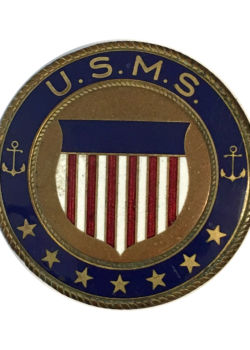
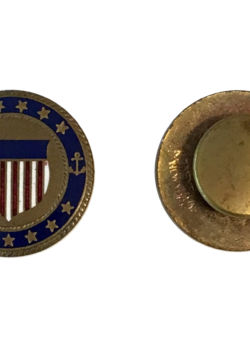
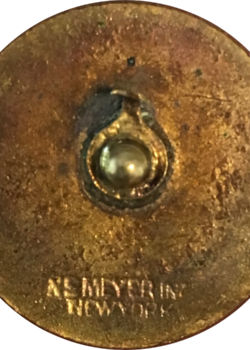
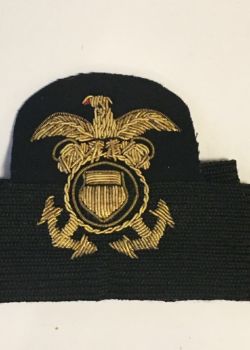
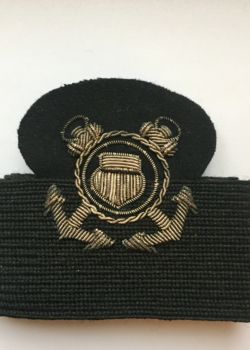






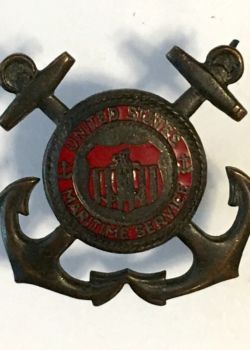


References
United States. Federal Register, January 9, 1942 (8 FR 1943). GPO, Washington D.C., 1943 p. 377.
United States, Maritime Commission. Uniform Regulations of United States Maritime Commission Cadet Corps (January 9, 1942). Washington, D.C., 1942.



































